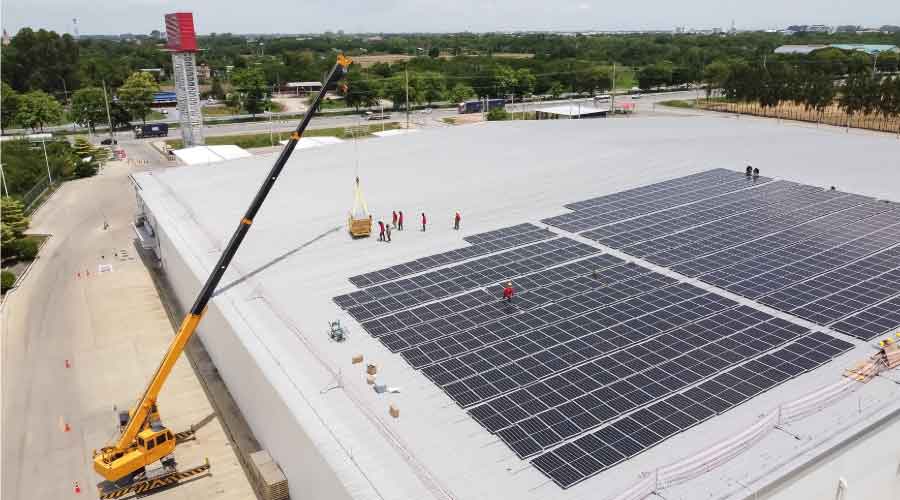
A new roof may be a once-in-a-career project for most facility managers. Here is what to consider from a sustainability standpoint to get your new roof right.
What’s definitely not obsolete is the importance of considering sustainability and energy efficiency in the selection of commercial roofs. Many building codes and green building rating systems now specify sustainability standards in roofing. Here are three sustainability criteria that facility managers should keep in mind as they’re selecting roofing products.
1.) Cool roofing
Cool roofing, the staple of sustainability for roofing systems, is as important today as it was decades ago – in fact, arguably more so today.
“The roofing industry has been focused on sustainability and cool roofing for the past two decades,” says John D’Annunzio, president of Paragon Roofing Technologies. “Reflectivity and emissivity rates of roof systems and materials are now required in design codes and all of the manufacturers provide materials to meet these requirements.”
Reflectivity is still the most important property of a cool roof. Reflectivity, or albedo, is a measure of how much of the sun’s energy is reflected away from the building. The more heat that is reflected, the cooler the building, and the less energy required for air conditioning. Thermal emittance, or emissivity, is the measure of how much energy a roof radiates away from the building after it has been absorbed. A measure known as Solar Reflectance Index (SRI) combines these two values into a single metric to compare different types of roofing. SRI is increasingly the measure du jour for green building rating systems like LEED and energy codes like California’s Title 24.
Even without the Energy Star designation to help facility managers select roofs, other tools like the Cool Roof Ratings Council’s database of cool roofing products — its Rated Product Directory — can help in product selection. Oak Ridge National Laboratory also maintains a “cool roof calculator” that lets users input variable to determine what roof might be best for their facilities.
“Cool roofing will remain a high priority for commercial buildings for roof longevity and energy savings,” says D’Annunzio. “The facility manager should work with roofing professionals to determine the best materials and systems for their specific building needs.”
2.) Durability
Similar to how the most sustainable building is one that doesn’t need to be built, the most sustainable roof is one that doesn’t need to be installed. That’s to say, getting a long life out of a durable roof is a sustainability strategy because it saves resources.
Regular inspections and preventive maintenance are the two most important strategies to making sure a roof lasts as long as it should.
“To achieve a long service life, a roof system must be properly designed, installed, and maintained,” says D’Annunzio. “The most important element of proper annual maintenance is to conduct the necessary material repairs that keep moisture from entering system. If the roof system (insulation) remains relatively dry, proper roof restoration can be completed to add service life to the existing materials. This eliminates costly and cumbersome roof removal.”
Roof coatings are another way to extend roof life without having to tear-off and install a whole new roof.
“Roof coatings are highly effective in extending the service life of existing roofs,” says D’Annunzio. “When used in combination with proper roof repairs and removal of wet materials, the roof coating materials that are currently on the market can provide both waterproofing and reflective properties. Discuss the current materials with roof manufacturers as the material choices vary based on the type of existing roof membrane that is on the building.”
3.) Cradle to Cradle Considerations
Though facility managers should employ every means necessary to get the most life out of their roof, even the most durable roof eventually will need to be replaced. When selecting a new roof, facility managers should consider how a product is made, and also, many years down the line, what will happen to it when its useful life expires.
Many roofing manufacturers now offer Environmental Product Declarations (EPDs) for their roofing products. These documents offer a snapshot of a product’s environmental life-cycle analysis, including the materials that make up a product. Some organizations, especially healthcare facilities, now have “red lists” of substances that are banned from being used in a facility. Facility managers can consult the EPD to ensure that none of an organization’s red list substances are used in the manufacture of the roofing material.
Considerations on how a product is made also include its recycled content — is a product made from virgin or recycled material? Of course, the latter is better in terms of sustainability. And the question should be considered, even though it’s many years in the future: Can this product be recycled at the end of its life? Some products include materials that preclude them from being recycled, so that is something facility managers should keep in mind as they’re selecting a roofing product.
By Greg Zimmerman, Senior Contributing Editor
Greg Zimmerman is senior contributor editor for the facility group, which including FacilitiesNet.com and Building Operating Management magazine. He has more than 18 years’ experience writing about facility issues.
The post "3 Elements of Roofing Sustainability" appeared first on Building Operating & Management







0 Comments